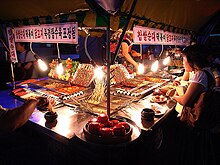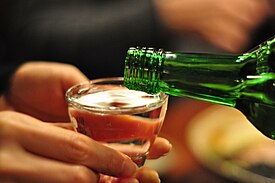Pojangmacha
| Pojangmacha | |
 Customers seated at apojangmachainGwangju(2006) | |
| Korean name | |
|---|---|
| Hangul | 포장마차 |
| Hanja | Bố trướng xe ngựa |
| Revised Romanization | pojangmacha |
| McCune–Reischauer | p'ochangmach'a |
Pojangmacha(Korean:포장마차;lit.covered wagon[1]), also abbreviated aspocha(포차), is a South Korean term for outdoor carts that sellstreet foodssuch ashotteok,gimbap,tteokbokki,sundae,dak-kkochi(Korean skewered chicken),[2]fish cake,mandu,andanju(foods accompanying drinks).[3]In the evening, many of these establishments serve alcoholic beverages such assoju.[4]
Pojangmachais a popular place to have a snack or drink late into the night. The food sold in these places can usually be eaten quickly while standing or taken away. Some offer cheap chairs or benches for customers to sit, especially the ones serving late night customers who come to drink soju.[5]
As of 2012[update],there were approximately 3,100 pocha inSeoul.[6]
Jongnois the most famous area for Pojangmacha but you can still find some decent food inGwangjang Market.Some pojangmacha in Jongno and other areas now offer set menus, with a combination of individual snacks put together in one plate.
History
[edit]Pojangmachadeveloped in the 1950s, after theend of Japanese rule in 1945.Vendors operated then much as they do today, although their equipment has changed. Mobile food carts were made stationary, wooden poles were erected around the cart, and cotton cloth would be hung around the cart to protect it and the customers from the elements. Over time, wood changed to metal, and cotton changed totarpaulin.Carbide lampswere converted toincandescent lights,fluorescentlights, and then toLEDs.[7]
Popular foods in the 1950s includednaengmyeon(cold noodles),sundae(sausages),bindae-tteok(mung bean pancakes),mandu(dumplings), and grilled seafood. During this period,pojangmachaserved refugees during theKorean War.Stalls also served alcohol, includingsoju,makgeolli,and beer.[7]
Since the 1980s,pojangmachastaple foods have reportedly remained relatively consistent. Around that time, stalls in Seoul, particularly in the Gangnam area, began receiving water dedicated water and electricity.[7]

In recent times,pochahas become an aesthetic in itself.[7]They feature prominently inSouth Korean dramasandfilms.[8]Some indoor restaurants and bars attempt to replicate the aesthetic, and are dubbed "indoorpojangmacha"(실내 포장마차).[7][8]
Menu
[edit]


Some stalls inJongno,Seoul,and other places offer set menus. For example,Gimbap,tteokbokki,andsundaeare served on one plate.[8]
Drinks
[edit]Food
[edit]- Dakbal(닭발)
- Twigim(튀김)
- Hoe(회)
- Tteokbokki(떡볶이)
- Eomuk(어묵)
- Gyeranmari(계란말이)
- Jeyuk bokkeum(제육볶음)
- Kimchi dubu (김치두부)
See also
[edit]References
[edit]- ^Elisa Ludwig (Mar 14, 2007)."Pojangmacha".citypaper.net. Archived fromthe originalon 2007-03-22.
- ^dakkochi
- ^Yi, Jason (2017-08-15)."Place From A Confessional: Pojangmacha Street Food".The RushOrder Blog.Archived fromthe originalon 2017-08-16.Retrieved2017-08-15.
- ^Goldberg, Lina"Asia's 10 greatest street food cities"Archived2012-03-25 at theWayback MachineCNN Go.23 March 2012. Retrieved 2012-04-11
- ^"Korean Food: Street Foods".Life in Korea.
- ^Oh, Esther"Guide to pojangmacha: Why Koreans love drinking in tents"Archived2012-03-30 at theWayback MachineCNN Go.23 March 2012. Retrieved 2012-04-13
- ^abcde김, 혜숙,"포장마차 ( bố trướng xe ngựa )",Encyclopedia of Korean Culture(in Korean),Academy of Korean Studies,retrieved2024-06-14
- ^abc"Why Pojangmacha Street Food Is What You Need".10 Magazine.October 26, 2016.
External links
[edit]- Why Pojangmacha Street Food Is What You Need10 Magazine,Charles Montgomery, October 26, 2016

